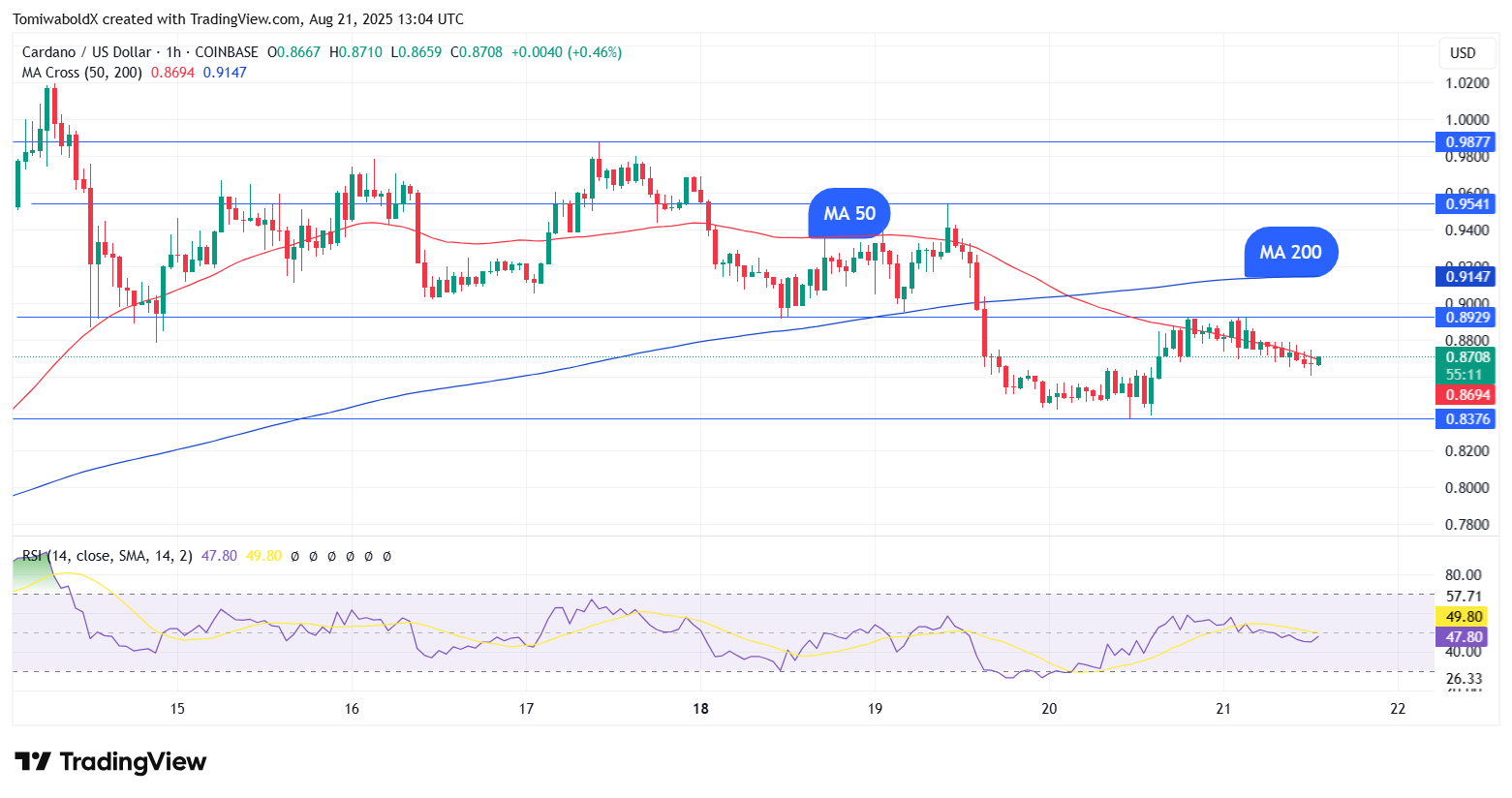Cardano death cross on the one-hour chart signals waning short-term momentum for ADA after a steep pullback; traders should watch moving averages, volume and macro cues like Fed signals to assess risk and potential rebound points.
-
Hourly death cross formed as short-term MA crossed below long-term MA
-
ADA dropped from $0.987 to $0.837 before a partial rebound to $0.863; weekly losses near 8.15%.
-
Macro data (higher July wholesale inflation) and Fed commentary drove Bitcoin below $112,000, amplifying sell pressure on altcoins.
Cardano death cross alerts traders to short-term bearish momentum in ADA; read the latest price action, Fed impact, and whale activity — stay updated with COINOTAG analysis.
What is the Cardano death cross on the hourly chart?
Cardano death cross is a technical signal where a short-term moving average crosses below a longer-term moving average on the one-hour chart, indicating diminished short-term bullish momentum. The signal is often lagging and should be interpreted with volume and broader market context.
How did ADA price action produce the death cross?
ADA fell from an Aug. 17 intraday high of $0.987 to a low of $0.837 before a sharp rebound. Short-term moving averages crossed below longer-term averages during that decline, creating the hourly death cross. Bitcoin’s pullback — dropping below $112,000 after an Aug. 14 high of $124,533 — intensified selling pressure across altcoins, including Cardano.

ADA/USD Hourly Chart, Courtesy: TradingView
The death cross signals short-term momentum loss, yet it often appears after the market is already oversold. Traders should not rely on the crossover alone; additional indicators like RSI, volume, and on-chain flows provide critical confirmation.
Why did macro data and Fed commentary impact ADA?
Higher-than-expected July wholesale inflation raised concerns that the Federal Reserve may delay rate cuts. Fed minutes confirmed policymakers saw inflation and labor-market risks and deemed it premature to lower rates. That stance pressured risk assets; Bitcoin led the sell-off, which then cascaded into large-cap altcoins such as Cardano.
What on-chain and market signals matter now?
Monitor these signals for context:
- Volume: declining selling volume on the rebound may indicate limited conviction.
- Whale activity: a notable accumulation — reported as 100 million ADA bought by large holders in 24 hours, per analyst Ali — can signal selective accumulation despite broader selling.
- Macro events: upcoming speeches (e.g., Powell at Jackson Hole) can quickly shift expectations and liquidity.
Frequently Asked Questions
Will the death cross on the hourly chart affect Cardano’s long-term trend?
A short-term hourly death cross typically does not change a long-term trend by itself. Long-term trend shifts require daily or weekly moving average crossovers, sustained on-chain outflows/inflows, and macro conditions changing over weeks.
How can traders use the death cross with risk management?
Use stop-losses below recent support, reduce position size, and wait for confirmation from volume or RSI. Monitor macro events and whale activity; these factors can invalidate the signal quickly.
Key Takeaways
- Death cross meaning: Short-term bearish crossover on ADA’s one-hour chart indicates fading momentum.
- Market drivers: Higher wholesale inflation and Fed minutes pressured risk assets, with Bitcoin’s drop amplifying ADA losses.
- Actionable insight: Combine the death cross with volume, RSI, and on-chain whale data before adjusting positions.
Conclusion
The emergence of a Cardano death cross on the hourly chart highlights short-term bearish pressure but is not a definitive sell signal alone. Traders should weigh technical indicators, on-chain whale accumulation, and macro updates from the Fed. COINOTAG will monitor developments and update readers as new data and price action unfold.
